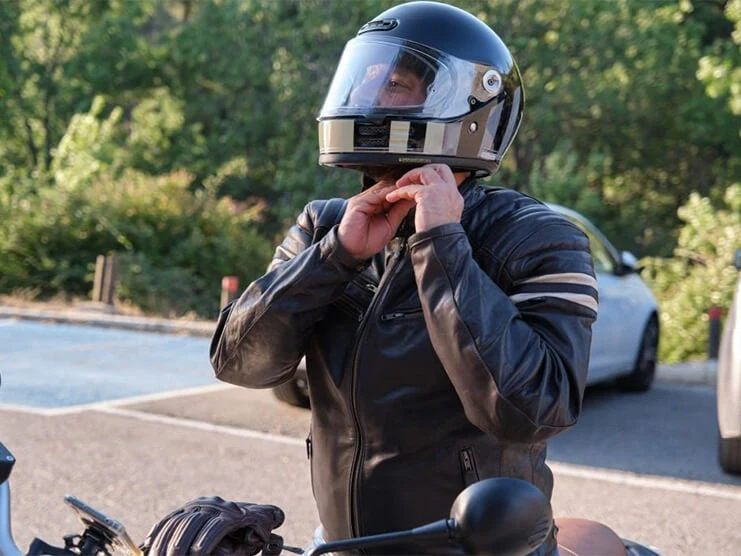Safety should be a priority for every motorcyclist when riding a two-wheeler. A motorcycle helmet contributes to more than 50% of motorcycle safety. Part of why a motorcycle helmet is so effective is because it stays put on your head during collisions. To reduce the risk of severe or fatal head injuries, you must wear a motorcycle helmet. This article will explain the importance of motorcycle helmet fitment.
Table of Content
1. Importance of a Motorcycle Helmet
A motorcycle helmet is an essential part of your riding gear it can. Despite the looks it highly accounts for motorcyclist’s safety. During accidents, the main threat to motorcyclists is a head injury which can be very fatal for them. Wearing motorcycle helmets increases the risk of severe injury by 69% and fatal injury by 42%.
Motorcycle helmets also provide protection from harsh weather conditions. The ventilation in helmets helps keep your head cool in summer. During winter, helmets help conserve body heat and protect your head from frosty winds. Motorcycle helmets with ear protection can help reduce the noise of the incoming wind. If you have long hair, a helmet can keep it from getting dirty or whipping around your face.
The color of your motorcycle riding gear is another thing that ensures your protection. It makes you visible to road users and pedestrians.
2. What to Look for in a Motorcycle Helmet
Wearing a helmet while riding a motorcycle is mandatory in almost every U.S. state. Listed below are what features to look for when buying a motorcycle helmet:
2.1 Helmet Shape
Every person’s head has a different shape. Some have perfectly round heads, while others have flat and rounded ones. To accommodate all riders, motorcycle helmets come in various shapes.
- Round Oval - Almost perfectly round from the forehead to the back of the skull and along the side length.
- Intermediate Oval - Fits the most common head shape, with the length from the forehead to the back of the skull being slightly shorter than the width between the sides.
- Long Oval - Designed for the head shape with a greater length from the forehead to the back of the skull than the width between the sides.
The intermediate oval helmet is the most common motorcycle helmet shape. A helmet’s shape is determined by the size and shape of a motorcyclist’s head.
2.2 Helmet Size
Motorcycle helmets can come in various sizes. Always wear a helmet that perfectly fits the size of your head. Determine the size of your head using a measuring tape and look for the best helmet with the closest dimensions.
Motorcycle Helmet Chart Size
| Size | Helmet Size | Head Circumference |
|---|---|---|
| X - Small | 6-5/8 - 6-3/4 | 20.87’’ - 21.26’’ (53 - 54 cm) |
| Small | 6-7/8 - 7 | 21.65’’ - 22.05 (55 - 56 cm) |
| Medium | 7-1/8 - 7-1/4 | 22.44’’ - 22.83 (57 - 58 cm) |
| Large | 7-3/8 - 7-1/2 | 23.23’’ - 23.62’’ (59 - 60 cm) |
| X - Large | 7-5/8 - 7-3/4 | 24.02’’ - 24.41’’ (61 -62 cm) |
| 2X - Large | 7-7/8 - 8 | 24.8’’ - 25.2’’ (63 - 64 cm) |
| 3X - Large | 8-1/8 - 8-1/4 | 25.6’’ - 26’’ (65 - 66 cm) |
| 4X - Large | 8-3/8 - 8-1/2 | 26.4’’ - 26.8’’ (67 - 68 cm) |
| 5X - Large | 8-5/8 - 8-3/4 | 27’’ - 27.5’’ (69 - 70 cm) |
2.3 Safety
A motorcycle helmet must be constructed from heavy-duty materials that can reduce bodily injury, prevent cracking, and perfectly fit your head. This will ensure that the helmet will stay on your head and absorb impacts during an accident.
2.4 Type

There are six types of motorcycle helmets to choose from, each with different features, sizes, and designs to better suit different rider preferences.
Full Face Helmets
Full face helmets provide complete coverage for your face and head. The chin bar protects your jaw and chin. In almost 50% of road accidents, motorcyclists reported that their chins were hurt the most. These helmets are built to protect the chin and gums.
Modular Helmets
Modular helmets are a combination of full and half-face helmets. They provide full protection like full-face helmets and include additional visors for eye protection and a chin bar.
Half Face Helmets
Half face helmets protect your head and half of your face, with the bottom half being exposed. However, this helps ensure better airflow into your helmet and the drawback is that motorcyclists have to compromise on their safety.
ADV Dual Sport
ADV dual sport helmets combine aspects of full-face and off-road helmets. They have large visors, low chin bars, and padding that makes them suited for on- and off-roading.
Half Shell Helmet
Half shell helmets are also called skull helmets since they protect the skull and ears. They are not suited for long trips as they offer minimal protection. They also do not have visors to protect your eyes from direct sunlight and UV rays. They are better suited for scooter users rather than motorcyclists.
Off-Road Helmet
Off-road helmets offer steady airflow and have a sharper shape with a broader visor.
3. Steps for Choosing a Perfectly Fitted Helmet
3.1 Select a Type of Helmet
First, you must decide which type of helmet you want to wear. Pick the criteria based on how frequently you ride your motorcycle and the conditions of the roads you travel. Depending upon your journey, you must choose the right style as your safety must be your main concern.
3.2 Determine Your Head Size
Measure your head size and cross-check it with a motorcycle helmet size chart.
3.3 Try on the Helmet
After you have determined the size of the helmet, try it on. While wearing it, check to see if there are any areas that are loose or tight. The cheek pads must not be too closely pressed against your cheeks or it could hurt your jaw.
The helmet is not an item that you can buy just by looking at or liking the color scheme. Follow the safety procedures and never compromise on your safety.
3.4 See if the Helmet Fits
While wearing the helmet, connect the straps. If you don’t feel a slight tightness around your head while wearing the helmet, it means that it is too loose. If the straps are cutting into your chin or you cannot squeeze your fingers through, the helmet may be too tight. After locking the straps try to pull the helmet, does it wear off? To check whether the chin strap is too tight or not, sneak two fingers.
Place both hands on the helmet to hold it in place while moving your head. If it only shifts along your cheeks, it means the helmet is a perfect fit. But If your head moves along with the helmet, this indicates it is loose.
3.5 Wear the Helmet for a Few Minutes
Wear the helmet for at least half an hour to properly examine it. If the helmet pinches your head and causes constant pain, it is not the right fit for you. Check the comfort liner to ensure it provides proper ventilation and absorbs unpleasant smells.
3.6 Check for Discomfort Due to Pressure
A motorcycle helmet should apply pressure equally around your head. If there is uneven pressure exerted on a part of your head, it could cause health issues later on. Ask yourself the following questions:
- Does the internal lining of the helmet fit your head?
- Do your cheeks hurt from the pressure applied by the cheek pads?
- Does the helmet protect your eyes from sunlight?
- Does the neck roll have enough padding to keep your neck warm during winter?
3.7 Check if it is DOT-Approved
Before buying a helmet, check whether it's DOT-approved or not. DOT-approved helmets are certified by the US Department of Transportation and mandatory for motorcyclists. There should be a DOT-approved stamp on the back of the helmet. Never buy a non-DOT-approved helmet and make sure your motorcycle helmet complies with your state’s helmet laws.
4. How to Measure the Size of Your Head for Motorcycle Helmet Fitment?
Take a measuring tape and wrap it around your head above the eyebrows. Measure your head at least two to three times, writing down and comparing the measurements to ensure accuracy. Use the largest measurement to determine the dimensions of your motorcycle helmet.
Select the helmet that accurately fits on your head. The straps of the helmet must not be too loose. A loose helmet will keep moving and may fall off your head upon collision, exposing you to injuries.
5. FAQs
5.1 Is it Good to Wear a Tight Helmet?
A motorcycle helmet shouldn’t be too tight or it could cause discomfort. If the cheek pads press against and hurt your cheeks, the helmet is not the right size.
5.2 What is the Safest Helmet to Wear?
A full-face helmet is the safest type of motorcycle helmet since it provides coverage for your face, neck, ears, and head.
6. Takeaway
Wearing a motorcycle helmet reduces the risk of head injuries by almost 69%. Motorcyclists choose different types of helmets according to the size of their heads. A perfectly fitted helmet doesn’t fall off during collisions and protects your head from blunt trauma. After you determine the size of your head, look for a DOT-approved motorcycle helmet that will offer optimal protection from dust, debris, and UV rays. Viking Bags offers many parts and luggage options, including sissy bars, fairing, handlebars, crash bars, sissy bar bags, and saddlebags for a better motorcycle riding experience.












Leave a comment
All comments are moderated before being published.
This site is protected by hCaptcha and the hCaptcha Privacy Policy and Terms of Service apply.